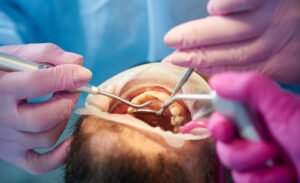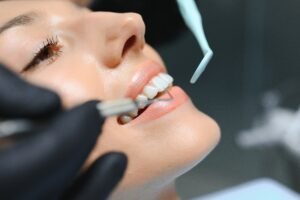Thumb sucking is a natural reflex observed in many infants and toddlers. For some, it’s a comforting mechanism; for others, it’s a habit formed before birth. But as children grow, especially once they begin teething, the implications of thumb sucking on Child’s Dental development come into the spotlight. This article delves into the nuances of this behavior. Its impact on dental health, and strategies for addressing prolonged thumb sucking.
To comprehend the dental implications, it’s essential first to understand why children suck their thumbs. Babies are often seen sucking their thumbs in utero during prenatal ultrasounds, indicating it’s a natural behavior, but it is part of a child’s dental development. For many infants, thumb sucking is a source of comfort, helping them navigate new sensations and experiences. It can also be a way to manage hunger or sleepiness.
When is Thumb Sucking a Concern?
Thumb sucking is generally harmless in babies and very young children. However, prolonged thumb sucking, especially beyond 4 or 5 years, can begin to influence dental and oral health in children
The primary concerns are:
Read More: Debunking 5 Common Misconceptions About Orthodontic Treatment
Misalignment of Teeth: Constant pressure from a thumb (or fingers) can prevent the front teeth from erupting properly. It may lead to anterior open bites (where the front teeth don’t meet when the back teeth do) or a crossbite.
Palatal Changes: The roof of the mouth or the palate can become altered or indented due to prolonged thumb sucking. This can further lead to speech problems or challenges with proper oral function.
Speech Impediments: Dental issues arising from thumb sucking can result in speech problems, particularly in articulating certain letters or sounds.
Germs and Infections: Children’s hands often come into contact with various surfaces, making them a hotspot for germs. Constant thumb-sucking as a part of child’s dental development can introduce these germs into the mouth, leading to infections.
Factors Determining Impact on Dental Development
Not every child who sucks their thumb will experience dental problems. Several factors determine the impact:
Intensity: Children who passively rest their thumbs in their mouths are less likely to have dental issues than those who vigorously suck their thumbs.
Must Read: Emergency Dentistry: What to Do When Dental Disaster Strikes
Duration: The longer a child continues the habit, the more likely dental problems can arise.
Frequency: Infrequent thumb sucking, such as only during sleep, poses less risk than constant thumb sucking throughout the day.
Managing and Breaking the Habit of Thumb Sucking During Child’s Dental Development
As part of a child’s dental development, thumb sucking ceases, especially as they engage in social activities or school. However, some might need a nudge to break the habit:
Positive Reinforcement: Reward children for not sucking their thumb, using praise or small incentives.
Identify Triggers: If a child sucks their thumb when anxious, try addressing the root of the anxiety rather than the thumb sucking itself.
Must Read: Invisible Alignment: The Invisalign Revolution in Teeth Straightening
Reminders: Use a bandage or a sock on the hand as a reminder.
Engage a Pediatric Dentist: Sometimes, a conversation with a pediatric dentist can encourage a child. Especially when they understand the importance of dental health.
Oral Appliances: In more extreme cases, a pediatric dentist might recommend a dental appliance to prevent the child from thumb sucking.
When to See a Pediatric Dentist for Thumb Sucking Concerns
While thumb sucking is natural in infancy and toddlerhood, parents must be vigilant about its potential effects on their child’s dental development. Here are instances when you should consider scheduling a visit with a pediatric dentist:
Persisting Beyond Toddlerhood: If your child continues to suck their thumb frequently past the age of 3. It’s a good idea to have a preliminary discussion with a dentist. They can offer guidance and monitor any early signs of dental issues.
Signs of Dental or Jaw Misalignment: If you begin to notice changes in the alignment of your child’s teeth or if their jaw does not seem to close completely at the front, a dentist’s intervention might be necessary.
Read More About: Say Goodbye to Bad Breath: 10 Effective Cures
Speech Difficulties: If your child shows signs of speech impediments, especially in pronouncing certain letters or sounds previously clear. It could be linked to dental alterations from thumb sucking.
Visible Palatal Changes: If you observe an indentation or change in the shape of the roof of your child’s mouth, it might be influenced by the thumb’s pressure.
Skin Problems on the Thumb: Persistent thumb sucking can lead to calluses, skin peeling, infections. Or other thumb-related concerns, which might need both dental and dermatological insights.
Maintaining regular dental checkups for your child, starting from their first tooth eruption, is always a good practice.
Regular visits to our pediatric dentists in Calgary ensure optimal dental health and offer opportunities to discuss concerns like thumb sucking. The pediatric dentist can provide tailored guidance based on the child’s oral development and the observed or potential effects of the habit.
Must Read: 10 Everyday Oral Hygiene Tips For Better Health
Conclusion
Thumb sucking is a natural, comforting reflex for many children. However, prolonged engagement in the habit can have implications for dental health and development. As with many aspects of pediatric health, the key lies in understanding, patience, and proactive management.
Consulting with our pediatric dentist at The Port Dental in Calgary can offer tailored advice and solutions to ensure a child’s dental development remains on track.
Proactively seeking dental consultations ensures that potential problems are addressed early. Laying the foundation for optimal dental health in the future.















